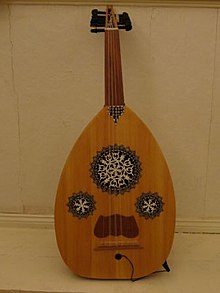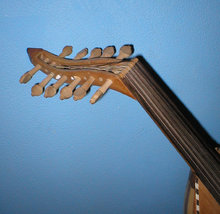Oud
![]()
The title of this article is ambiguous. For other meanings, see Oud (disambiguation).
The oud or ud, also used in the masculine (Arabic عود, DMG ʿūd, mascul. sg. , with article: Arabic العود, DMG al-ʿūd), is a short-necked lute from the Near East belonging to the shell-necked lutes. As a forerunner of the European lute, the instrument, which was probably originally native to Persia, came to Europe with the Arab expansion in the 7th to 9th centuries and via the Moors in Andalusia as well as via returning crusaders. Bent-necked lutes in Transcaucasia can also be traced back to the oud. Oud means "wood"; however, more recently an etymology via Persian rud, "stringed instrument," has also been proposed. In contemporary Iranian music, the Arabic lute is also referred to as بربط / barbaṭ in Persian playing tradition.
The Arabian lute is considered the most flexible and dynamic of the Middle Eastern stringed instruments. Today it is also a widespread instrument in folk music. The great variety of playing styles and tunings made it an important instrument of courtly music. It was called the "prince of musical instruments" and became a popular subject of systematic treatises on music theory, making it ubiquitous in Arabic musical culture.

Arabian oud
History
The origin of the Arabic lute has not been conclusively determined. The Arabs probably adopted the thick-bellied shape of the Persian barbat lute with its wooden top and substituted it for an older pear-shaped instrument of the type of the Turkish lute kopuz or the skin-covered Yemenite qanbus. Stringed instruments similar to the lute, however, existed among the Sumerians, the Babylonians, and in ancient Egypt, and were apparently already in use in pre-Islamic Arabia. Medieval Muslim scholars such as al-Masʿūdī or al-Fārābī, who described the oud in detail in a treatise on music theory in the 10th century, saw the origins of the oud either in Greek culture or attributed its invention to the biblical Lamech. According to the myth, Lamech hung the corpse of his deceased son on a tree in mourning and was inspired by the skeletal form to design the instrument.
The oldest illustration of an oud is found on an ivory vessel from Cordoba dated to the year 868. In Arabic music the oud was initially used to perform impromptu songs. The structure and form of the instrument underwent constant change over the centuries: while the older lutes resembled the shape of an almond and were generally made from a single piece, later instruments took on a rounder shape and were composed of several parts; in particular, they then often had a separate neck. And while an 11th-century building instruction prepared by a leading musician at the Fatimid court still recommended that only one type of wood be used for its manufacture, namely that of the cypress, the oud described by Guillaume-André Villoteau in the Description de l'Egypte consisted of a total of nine different types of wood.
In the Middle Ages, the oud found its way to Europe on the one hand via Spain in the west and on the other hand through returning crusaders via Byzantium in the east. Troubadours, trouveres and itinerant musicians accompanied their singing with the instrument. The popularity of the lute in Europe reached its peak in the 16th century. The names given to the instrument in various European languages - German lute, Portuguese alaude, Spanish laud, French luth, Italian liuto and English lute - are all derived from the Arabic word al-Oud.

Swirl box of an oud
Structure and material
The potbellied, half-pear-shaped bowl body has been composed of several wood chips since at least the 9th century. The top has a sound hole carved with rosette-like arabesques. At the neck is the pegbox, which is bent backwards.
Unlike the European lute, today's oud has no frets and usually had four strings from the 7th to the 9th century. The famous musician and music theorist Ziryab added a fifth string (supposedly made of lion's arm, as opposed to the silk common at the time). Today the oud is strung with double chords (usually six pairs of strings or five chords and a single string); modern strings are usually made (along the lines of the concert guitar) of nylon silk, with the bass strings wound with metal wire-such as silver, copper, or various alloys. Before the advent of modern methods of factory string making, a wide variety of materials were used for this purpose, depending on the era and regional conditions, for example natural gut, silk, animal sinew, leather and various natural fibres.
Search within the encyclopedia